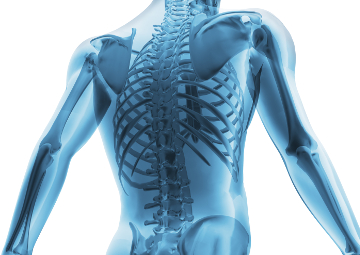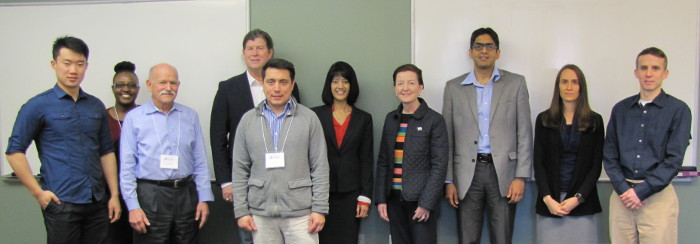| Description | Participants | Summaries | Products |
|---|
NIMBioS Working Group:
3D Modeling of Human Body Composition

Topic: Automatic 3D modeling of human morphology and body composition
Meeting dates: March 13-14, 2017
Organizers:
Steven B. Heymsfield, Pennington Biomedical Research Center, Baton Rouge, LA
Diana Thomas, Center for Quantitative Obesity Research, Montclair State Univ., NJ; USMA
Nakeya Williams, Mathematical Sciences, US Military Academy, West Point, NY
Michael Yankovich, Mathematical Sciences, US Military Academy, West Point, NY
Objectives: Laser image technology has provided a novel method to automatically develop a 3D rendering of the human body, eliminating the reliance on burdensome and often inaccurate clinical measurements such as body mass index (BMI) and waist circumference. The purpose of this working group is to bring together a uniquely diverse team of investigators from body composition, mathematical modeling, and the military to 1) derive accurate predictions of muscle, bone, and fat mass from the reconstructed image; 2) develop cardiovascular risks and thermoregulation scores that align to every available geometrical measurement of body shape acquired from the image; and 3) design and clinically deploy a user-friendly software tool to automatically deliver predictions. To date, these problems have not been addressed because of the lack of data with simultaneous measures and a gap in mathematical expertise on clinical research teams involved in data collection. This working group assembles the requisite expertise and will have access to a state-of-the-art database containing laser images from 1500 subjects, with concomitant measures of magnetic resonance imaging (MRI) assessed body composition, blood work, cardiovascular markers of health, and individual lipid panels. This database is the first of its kind to simultaneously obtain body composition measured using state of the art technology and health status combined with 3D rendered images of the human body.

Meeting Summaries
| Mtg # | Dates | Agenda | Summary | Photo | Evaluation |
|---|---|---|---|---|---|
| 1 | Mar 13-14, 2017 | Link | Link | Report |
Meeting 1 Summary. The advent of new 3D body shape modeling technology generated many novel and exciting ideas and applications. Presentations were made by John Shephard, Steven Heymsfield, Dympna Gallagher, Diana Thomas, Courtney Peterson, Michael Yankovich, Issac Tian,Satish Vishwanath and Nakeya Williams. The presentations spanned the current state of the field in technology involving 3D body shape modeling along with potential applications and open questions that 3D Body shape modeling can address. On the last day, we held a roundtable discussion on next steps. We listed a large set of open problems involving prediction of disease states, epidemiological studies, and performance/injury prediction in athletes and military personnel. Our group felt that a cross-cutting review article on the state of machine learning applied to body shape/weight/obesity would serve as an important first step. We anticipate submission by the end of August. We also felt that a follow-up symposium directed at predicting athletic/military performance and injuries should be held at the United States Military Academy. The focused symposium, which will host professional sport team trainers and military personnel, will be held on September 20, 2017.
 |
| Meeting 1 participants (L to R): Isaac Tian, Nakeya Williams, Steven Heymsfield, John Shepherd, Patrick Kuiper, Diana Thomas, Dympna Gallagher, Satish Viswanath, Courtney M. Peterson, Michael Yankovich. |
NIMBioS Working Groups are chosen to focus on major scientific questions at the interface between biology and mathematics. NIMBioS is particularly interested in questions that integrate diverse fields, require synthesis at multiple scales, and/or make use of or require development of new mathematical/computational approaches. NIMBioS Working Groups are relatively small (up to 10 participants), focus on a well-defined topic, and have well-defined goals and metrics of success. Working Groups will meet up to 3 times over a two-year period, with each meeting lasting up to 2.5 days.
A goal of NIMBioS is to enhance the cadre of researchers capable of interdisciplinary efforts across mathematics and biology. As part of this goal, NIMBioS is committed to promoting diversity in all its activities. Diversity is considered in all its aspects, social and scientific, including gender, ethnicity, scientific field, career stage, geography and type of home institution. Questions regarding diversity issues should be directed to diversity@nimbios.org. You can read more about our Diversity Plan on our NIMBioS Policies web page. The NIMBioS building is fully handicapped accessible.
NIMBioS
1122 Volunteer Blvd., Suite 106
University of Tennessee
Knoxville,
TN 37996-3410
PH: (865) 974-9334
FAX: (865) 974-9461
Contact NIMBioS


